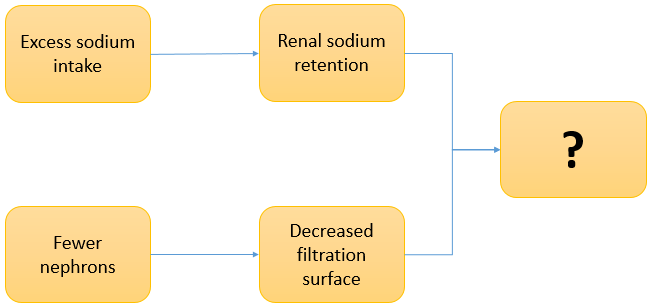This set of Drug Biotechnology MCQs focuses on “Histamine, Bradykinin and Their Antagonists – Pharmacotherapy of Hypertension – 2”.
1. Choose the correct option for the marked place.

a) Decrease of calcium ion
b) Increase of potassium volume
c) Increase of fluid volume
d) Decrease of fluid volume
View Answer
Explanation: Excess sodium intake leads to an increase in fluid volume. If there are fewer nephrons that imply decreased surface for filtration thus the renal sodium retention will be higher. The preload will be higher thus the blood pressure will be high. Thus hypertension patients are prescribed not to have much sodium intake.
2. Choose the correct option for the marked place.

a) Decrease of calcium ion
b) Increasing contractility
c) Increase of fluid volume
d) Decrease of fluid volume
View Answer
Explanation: Stress leads to decreased filtration surface for the nephrons, over activity of the sympathetic nervous system and excess secretion of renin-angiotensin. Over activity of the sympathetic nervous system leads to an increase of the contractility of the blood vessel. Thus narrowing of the blood vessel means more fluid flowing through a narrow route and an increase of the pressure per sq. centimetre. This increases the blood pressure.
3. Which enzyme should be present for the conversion of angiotensinogen to angiotensin I?

a) Renin
b) Angiotensin converting enzyme
c) Calcium ions
d) Calcium anhydrase inhibitors
View Answer
Explanation: The juxtaglomerular cells of kidney release renin, this renin helps to convert angiotensinogen to angiotensin I. Angiotensin converting enzyme helps to convert angiotensin I to angiotensin II which gets attached to the angiotensin II receptor sites present in blood vessels and capillaries of lungs. Calcium channel blockers work in the vascular smooth muscle and decrease muscle contraction.
4. Which of the flowing enzyme should be present in the marked place?

a) Renin
b) Angiotensin converting enzyme
c) Calcium ions
d) Calcium anhydrase inhibitors
View Answer
Explanation: Renin is a very important enzyme which is used to convert the Angiotensinogen to Angiotensin I. The renin is releases by juxtaglomerular cells of kidney. Angiotensin I is converted to angiotensin II in the presence of angiotensin converting enzyme. Angiotensin converting enzyme gets attached to the angiotensin II receptor sites present in blood vessels and capillaries of lungs.
5. Which should be done if the 3rd line treatment of hypertension is not enough for a patient?
a) Diuretic
b) Angiotensin-converting enzyme inhibitor
c) Increase drug dose
d) Need further studies
View Answer
Explanation: 1st line treatment should continue with lifestyle modification, initial drug selection should be diuretic, beta-blocker. If inadequate, continue to second-line treatment which includes adding drugs such as Angiotensin Converting Enzyme (ACE) Inhibitor, Calcium Channel Blocker, Angiotensin II Receptor Blocker (ARB), α- blocker, α- and β-blocker. If inadequate, continue to third line treatment increase drug dose or Substitute another drug or add a second drug from another class. If inadequate may need to do further studies serious organ damage may be present.
6. Where β1 beta receptors are found mostly in the body?
a) Liver
b) Kidney
c) Heart
d) Lungs
View Answer
Explanation: Beta blockers are Beta-adrenergic receptor blockers – they block the action of Adrenalin and Noradrenaline (SNS stimulants), which are involved in “Fight-or-flight’ response. There are two types of Beta receptors β1 – found mostly in the heart and β2 – found mostly in the lungs.
7. Which of the drug is a type of ACE inhibitor?
a) Captopril
b) Irbesartan
c) Amlodipine
d) Furosemide
View Answer
Explanation: Diuretics example is furosemide, Hydrochlorothiazide. A beta-blockers example is Atenolol, Propranolol. ACE inhibitors are captopril, enalapril. Calcium channel blocker examples are amlodipine, Diltiazem.
8. Beta-blockers increase blood flow to the kidneys.
a) True
b) False
View Answer
Explanation: Action of Beta-Blockers are blocked vasoconstriction, decrease heart rate, and decrease cardiac muscle contraction. It also tends to increase blood flow to the kidneys leading to a decrease in the release of renin. Beta blockers are Beta-adrenergic receptor blockers – they block the action of Adrenalin and Noradrenaline (SNS stimulants), which are involved in “Fight-or-flight’ response.
9. There are many side effects of beta blockers including fatigue, blurred vision, impotence, bradycardia, pulmonary edema.
a) True
b) False
View Answer
Explanation: The side effects of Beta blockers are fatigue, orthostatic hypotension, weakness, blurred vision, stuffy nose, impotence, rash, bradycardia, pulmonary edema. Treatment of side effects is changing position slowly, sit at the edge of bed or chair for a few minutes before standing up, drink an adequate amount of fluids, contact physician in more serious case to adjust the dose or change the medication.
Sanfoundry Global Education & Learning Series – Drug and Pharmaceutical Biotechnology.
To practice MCQs on all areas of Drug Biotechnology, here is complete set of 1000+ Multiple Choice Questions and Answers.
If you find a mistake in question / option / answer, kindly take a screenshot and email to [email protected]
- Check Biotechnology Books
- Apply for Biotechnology Internship
- Practice Biotechnology MCQs
- Check Drug and Pharmaceutical Biotechnology Books
